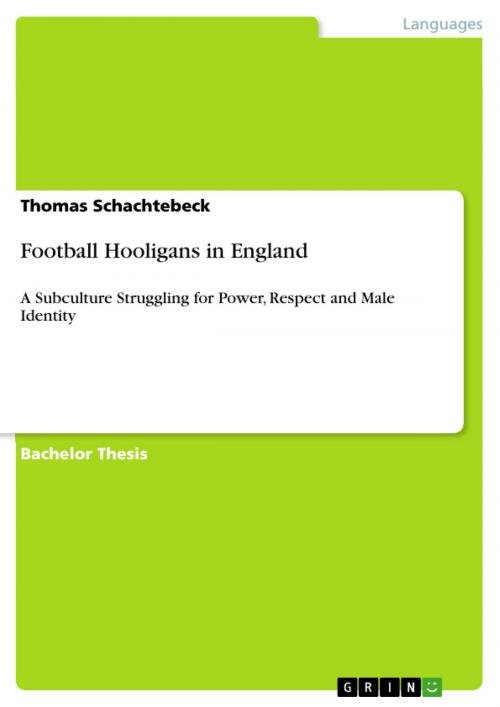Football Hooligans in England
A Subculture Struggling for Power, Respect and Male Identity
Nonfiction, Entertainment, Drama, Anthologies| Author: | Thomas Schachtebeck | ISBN: | 9783640808403 |
| Publisher: | GRIN Verlag | Publication: | January 24, 2011 |
| Imprint: | GRIN Verlag | Language: | English |
| Author: | Thomas Schachtebeck |
| ISBN: | 9783640808403 |
| Publisher: | GRIN Verlag |
| Publication: | January 24, 2011 |
| Imprint: | GRIN Verlag |
| Language: | English |
Bachelor Thesis from the year 2007 in the subject English - Miscellaneous, grade: 2,0, Free University of Berlin (Fachbereich Englisch), course: Verttiefungsmodul Culture - Gender - Media II, language: English, abstract: Contents 1Introduction 2Spotlight on Football Hooligans - A Theoretical Background 2.1Defining the Terms 'Hooligan' and 'Hooliganism' 2.2The History of Football Hooliganism in England 2.3The Subculture of Football Hooligans - Specific Characteristics, Attitudes and Behaviour Patterns 2.4A Typical Day of Football Hooligans 3The Representation of Masculinity in John King's The Football Factory 3.1The Meaning of Violence and Gang Fights 3.2The Importance of Male Bonding 3.3Male Sexuality and the Protagonist's Attitude towards Women 4Conclusion References [...] The reason why the phenomenon of hooliganism is so strongly linked to football is because this kind of sport is seen 'as an appropriate venue for [...] aggressive rivalries, partly because of the working class roots and traditions of the game but also because of the culturally prescribed 'territorial' and masculine values which are intrinsic to it.' (Sir Norman Chester Centre for Football Research 2001: 1) Thus, there is no doubt that typical attitudes and emotions representing 'true masculinity' (Holt 1989: 8), such as the celebration of physical strength and the loyalty to 'mates' or to a specific territory, are traditional and popular features of football culture. [...] Since meanwhile, the male-dominated subculture of football hooligans has not only grown to a serious problem in England but also in many other countries around Europe, football-related antisocial behaviour has become a subject to much discussion about masculinity and subcultures in the fields of academics and the media over the past several years and decades. Consequently, my paper aims at presenting football hooliganism as a male subculture with its own values and rituals, which are clearly different from those of our dominant culture, and, furthermore, it tries to analyse what images of masculinity are associated with the subculture of - particularly English - football hooligans. Therefore, my paper will first provide some important theoretical background information about hooligans, which are necessary in order to get into the topic of football hooliganism more elaborately. Then, it will analyse why hooligans belong to a certain form of subculture by presenting and explaining specific characteristics, attitudes and behaviour patterns of football hooligans, and, finally, it shall explore what kind of masculinity is represented by the football hooligans described in John King's novel The Football Factory.
Bachelor Thesis from the year 2007 in the subject English - Miscellaneous, grade: 2,0, Free University of Berlin (Fachbereich Englisch), course: Verttiefungsmodul Culture - Gender - Media II, language: English, abstract: Contents 1Introduction 2Spotlight on Football Hooligans - A Theoretical Background 2.1Defining the Terms 'Hooligan' and 'Hooliganism' 2.2The History of Football Hooliganism in England 2.3The Subculture of Football Hooligans - Specific Characteristics, Attitudes and Behaviour Patterns 2.4A Typical Day of Football Hooligans 3The Representation of Masculinity in John King's The Football Factory 3.1The Meaning of Violence and Gang Fights 3.2The Importance of Male Bonding 3.3Male Sexuality and the Protagonist's Attitude towards Women 4Conclusion References [...] The reason why the phenomenon of hooliganism is so strongly linked to football is because this kind of sport is seen 'as an appropriate venue for [...] aggressive rivalries, partly because of the working class roots and traditions of the game but also because of the culturally prescribed 'territorial' and masculine values which are intrinsic to it.' (Sir Norman Chester Centre for Football Research 2001: 1) Thus, there is no doubt that typical attitudes and emotions representing 'true masculinity' (Holt 1989: 8), such as the celebration of physical strength and the loyalty to 'mates' or to a specific territory, are traditional and popular features of football culture. [...] Since meanwhile, the male-dominated subculture of football hooligans has not only grown to a serious problem in England but also in many other countries around Europe, football-related antisocial behaviour has become a subject to much discussion about masculinity and subcultures in the fields of academics and the media over the past several years and decades. Consequently, my paper aims at presenting football hooliganism as a male subculture with its own values and rituals, which are clearly different from those of our dominant culture, and, furthermore, it tries to analyse what images of masculinity are associated with the subculture of - particularly English - football hooligans. Therefore, my paper will first provide some important theoretical background information about hooligans, which are necessary in order to get into the topic of football hooliganism more elaborately. Then, it will analyse why hooligans belong to a certain form of subculture by presenting and explaining specific characteristics, attitudes and behaviour patterns of football hooligans, and, finally, it shall explore what kind of masculinity is represented by the football hooligans described in John King's novel The Football Factory.















